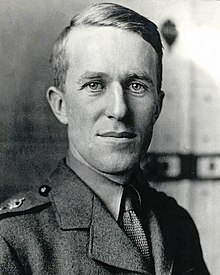T E Lawrence
|
Colonel T. E. Lawrence CB DSO |
|
|---|---|

Lawrence in 1919
|
|
| Birth name | Thomas Edward Lawrence |
| Other name(s) | T. E. Shaw, John Hume Ross |
| Nickname(s) | Lawrence of Arabia |
| Born |
16 August 1888 Tremadog, Carnarvonshire, Wales |
| Died | 19 May 1935 (aged 46) Bovington Camp, Dorset, England |
| Buried | St Nicholas, Moreton, Dorset |
| Allegiance | United Kingdom Kingdom of Hejaz |
| Service/ |
British Army Royal Air Force |
| Years of service | 1914–1918 1923–1935 |
| Rank |
Colonel (British Army) Aircraftman (RAF) |
| Battles/wars | |
| Awards |
Companion of the Order of the Bath Distinguished Service Order Knight of the Legion of Honour (France) Croix de guerre (France) |
Thomas Edward Lawrence, CB, DSO (16 August 1888 – 19 May 1935) was a British archaeologist, military officer, diplomat, and writer. He was renowned for his liaison role during the Sinai and Palestine Campaign and the Arab Revolt against the Ottoman Empire during the First World War. The breadth and variety of his activities and associations, and his ability to describe them vividly in writing, earned him international fame as Lawrence of Arabia—a title used for the 1962 film based on his wartime activities.
Lawrence was born out of wedlock in Tremadog, Wales, in August 1888 to Thomas Chapman (who became, in 1914, Sir Thomas Chapman, 7th Baronet), an Anglo-Irish nobleman from County Westmeath, and Sarah Junner, a Scottish governess who was herself illegitimate. Chapman had left his wife and first family in Ireland to live with Junner, and they called themselves Mr and Mrs Lawrence. In 1896, the Lawrences moved to Oxford, where Lawrence attended the High School and in 1907–1910 studied History at Jesus College, Oxford. Between 1910 and 1914 he worked as an archaeologist, chiefly at Carchemish, in what is now Syria.
Soon after the outbreak of war he volunteered for the British Army and was stationed in Egypt. In 1916, he was sent to Arabia on an intelligence mission and quickly became involved with the Arab Revolt, serving, along with other British officers, as a liaison to the Arab forces. Working closely with Emir Faisal, a leader of the revolt, he participated in and sometimes led military activities against the Ottoman armed forces, culminating in the capture of Damascus in October 1918.
...
Wikipedia
